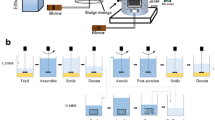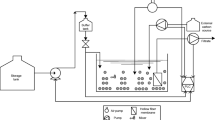Abstract
For the treatment of high-strength pyridine containing wastewater, a bioaugmented continuous-flow self-forming dynamic membrane bioreactor (CSFDMBR), which was consisted of a continuous flow airlift reactor (CFAR) and a dynamic membrane bioreactor (DMBR), was developed in this study. The results indicated that through the bioaugmentation by Rhizobium sp. NJUST18, CSFDMBR could be successfully started, which was confirmed by complete removal of pyridine, efficient nitrification, and significant increase of biomass. Pyridine could be effectively degraded in the CSFDMBR even at influent pyridine loading rate as high as 9.0 kg m−3 day−1, probably due to the efficient biomass retention in the CSFDMBR, which could be attributed to the formation of aerobic granules and the key role of dynamic membrane. CSFDMBR presented good polishing performance in treating pyridine wastewater, with effluent total organic carbon (TOC) and turbidity as low as 22.5 ± 6.8 mg L−1 and 3.8 ± 0.5 NTU, respectively. Membrane fouling could be effectively controlled, as indicated by backwash period as long as 60 days. The observed efficient performance highlights the potential for the full-scale application of the bioaugmented CSFDMBR, particularly for highly recalcitrant pollutant removal.








Similar content being viewed by others
References
Adav SS, Lee DJ, Ren NQ (2007) Biodegradation of pyridine using aerobic granules in the presence of phenol. Water Res 41(13):2903–2910
Bai Y, Sun Q, Zhao C et al (2008) Microbial degradation and metabolic pathway of pyridine by a Paracoccus sp. strain BW001. Biodegradation 19(6):915–926
Bai Y, Sun Q, Zhao C et al (2009) Aerobic degradation of pyridine by a new bacterial strain, Shinella zoogloeoides BC026. J Ind Microbiol Biotechnol 36(11):1391–1400
Bai Y, Sun Q, Zhao C et al (2010) Bioaugmentation treatment for coking wastewater containing pyridine and quinoline in a sequencing batch reactor. Appl Microbiol Biotechnol 87(5):1943–1951
Bokhove J, Schuur B, De Haan AB (2012) Solvent design for trace removal of pyridines from aqueous streams using solvent impregnated resins. Sep Purif Technol 98:410–418
Chandra R, Bharagava RN, Kapley A et al (2009) Isolation and characterization of potential aerobic bacteria capable for pyridine degradation in presence of picoline, phenol and formaldehyde as co-pollutants. World J Microbiol Biotechnol 2009 25(12):2113–2119
Ersahin ME, Gimenez JB, Ozgun H et al (2016) Gas-lift anaerobic dynamic membrane bioreactors for high strength synthetic wastewater treatment: effect of biogas sparging velocity and HRT on treatment performance. Chem Eng J. doi:10.1016/j.cej.2016.02.003
Fan B, Huang X (2002) Characteristics of a self-forming dynamic membrane coupled with a bioreactor for municipal wastewater treatment. Environ Sci Technol 36(23):5245–5251
Ho L, Ho G (2012) Mitigating ammonia inhibition of thermophilic anaerobic treatment of digested piggery wastewater: use of pH reduction, zeolite, biomass and humic acid. Water Res 46(14):4339–4350
Lataye DH, Mishra IM, Mall ID (2006) Removal of pyridine from aqueous solution by adsorption on bagasse fly ash. Ind Eng Chem Res 45(11):3934–3943
Lay-Son M, Drakides C (2008) New approach to optimize operational conditions for the biological treatment of a high-strength thiocyanate and ammonium waste: pH as key factor. Water Res 42(3):774–780
Li J, Cai W, Cai J (2009) The characteristics and mechanisms of pyridine biodegradation by Streptomyces sp. J Hazard Mater 165(1):950–954
Li X, Gao F, Hua Z et al (2005) Treatment of synthetic wastewater by a novel MBR with granular sludge developed for controlling membrane fouling. Sep Purif Technol 46(1):19–25
Liang S, Zhao T, Zhang J et al (2012) Determination of fouling-related critical flux in self-forming dynamic membrane bioreactors: interference of membrane compressibility. J Membr Sci 390:113–120
Liu X, Chen Y, Zhang X et al (2015) Aerobic granulation strategy for bioaugmentation of a sequencing batch reactor (SBR) treating high strength pyridine wastewater. J Hazard Mater 295:153–160
Liu C, Huang X, Wang H (2008) Start-up of a membrane bioreactor bioaugmented with genetically engineered microorganism for enhanced treatment of atrazine containing wastewater. Desalination 231(1):12–19
Liu H, Li Y, Yang C et al (2012a) Stable aerobic granules in continuous-flow bioreactor with self-forming dynamic membrane. Bioresour Technol 121:111–118
Liu G, Ye Z, Li H et al (2012b) Biological treatment of hexanitrostilbene (HNS) produced wastewater using an anaerobic–aerobic immobilized microbial system. Chem Eng J 213:118–124
Mathur AK, Majumder CB, Chatterjee S et al (2008) Biodegradation of pyridine by the new bacterial isolates S. putrefaciens and B. sphaericus. J Hazard Mater 157(2):335–343
Metreveli AK, Metreveli PK, Makarov IE (2013) Aromatic products of radiation-thermal degradation of lignin and chitin. High Energ Chem 47(2):35–40
Mohan D, Singh KP, Sinha S et al (2004) Removal of pyridine from aqueous solution using low cost activated carbons derived from agricultural waste materials. Carbon 42(12):2409–2421
Mohan SV, Sistla S, Guru RK et al (2003) Microbial degradation of pyridine using Pseudomonas sp. and isolation of plasmid responsible for degradation. Waste Manag 23(2):167–171
Mudliar SN, Padoley KV, Bhatt P et al (2008) Pyridine biodegradation in a novel rotating rope bioreactor. Bioresour Technol 99(5):1044–1051
Padoley KV, Mudliar SN, Banerjee SK et al (2011) Fenton oxidation: a pretreatment option for improved biological treatment of pyridine and 3-cyanopyridine plant wastewater. Chem Eng J 166(1):1–9
Padoley KV, Rajvaidya AS, Subbarao TV et al (2006) Biodegradation of pyridine in a completely mixed activated sludge process. Bioresour Technol 97(10):1225–1236
Park S, Bae W (2009) Modeling kinetics of ammonium oxidation and nitrite oxidation under simultaneous inhibition by free ammonia and free nitrous acid. Process Biochem 44(6):631–640
Qiao L, Wang J (2010) Microbial degradation of pyridine by Paracoccus sp. isolated from contaminated soil. J Hazard Mater 176(1):220–225
Qiao L, Wen DH, Wang JL (2010) Biodegradation of pyridine by Paracoccus sp. KT-5 immobilized on bamboo-based activated carbon. Bioresour Technol 101(14):5229–5234
Rhee SK, Lee ST, Lee KY et al (1997) Degradation of pyridine by Nocardioides sp. strain OS4 isolated from the oxic zone of a spent shale column. Can J Microbiol 43(2):205–209
Shen J, Chen Y, Wu S et al (2015a) Enhanced pyridine biodegradation under anoxic condition: the key role of nitrate as the electron acceptor. Chem Eng J 277:140–149
Shen J, Zhang X, Chen D et al (2014) Kinetics study of pyridine biodegradation by a novel bacterial strain, Rhizobium sp. NJUST18. Bioprocess Biosyst Eng 37(6):1185–1192
Shen J, Zhang X, Chen D et al (2015b) Characteristics of pyridine biodegradation by a novel bacterial strain, Rhizobium sp. NJUST18. Desalin Water Treat 53(7):2005–2013
Shen J, He R, Yu H et al (2009) Biodegradation of 2, 4, 6-trinitrophenol (picric acid) in a biological aerated filter (BAF). Bioresour Technol 100(6):1922–1930
Stobdan T, Sinha A, Singh RP et al (2008) Degradation of pyridine and 4-methylpyridine by Gordonia terrea IIPN1. Biodegradation 19(4):481–487
Sun JQ, Xu L, Tang YQ et al (2011) Degradation of pyridine by one Rhodococcus strain in the presence of chromium (VI) or phenol. J Hazard Mater 191(1):62–68
Tadkaew N, Sivakumar M, Khan SJ et al (2010) Effect of mixed liquor pH on the removal of trace organic contaminants in a membrane bioreactor. Bioresour Technol 101(5):1494–1500
Uma B, Sandhya S (1998) Kinetics of pyridine degradation along with toluene and methylene chloride with Bacillus sp. in packed bed reactor. Bioprocess Eng 18(4):303–305
Wei D, Wang Y, Wang X et al (2015) Toxicity assessment of 4-chlorophenol to aerobic granular sludge and its interaction with extracellular polymeric substances. J Hazard Mater 289:101–107
Wen D, Zhang J, Xiong R et al (2013) Bioaugmentation with a pyridine-degrading bacterium in a membrane bioreactor treating pharmaceutical wastewater. J Environ Sci 25(11):2265–2271
Yang SF, Tay JH, Liu Y (2004) Inhibition of free ammonia to the formation of aerobic granules. Biochem Eng J 17(1):41–48
Yu Z, Chu H, Cao D et al (2012) Pilot-scale hybrid bio-diatomite/dynamic membrane reactor for slightly polluted raw water purification. Desalination 285:73–82
Zalat OA, Elsayed MA (2013) A study on microwave removal of pyridine from wastewater. J Environ Chem Eng 1(3):137–143
Zhang W, Cao B, Wang D (2016) Influence of wastewater sludge treatment using combined peroxyacetic acid oxidation and inorganic coagulants re-flocculation on characteristics of extracellular polymeric substances (EPS). Water Res 88:728–739
Zhang X, Wang Z, Wu Z et al (2010) Formation of dynamic membrane in an anaerobic membrane bioreactor for municipal wastewater treatment. Chem Eng J 165(1):175–183
Zhang X, Wang Z, Wu Z et al (2011) Membrane fouling in an anaerobic dynamic membrane bioreactor (AnDMBR) for municipal wastewater treatment: characteristics of membrane foulants and bulk sludge. Process Biochem 46(8):1538–1544
Zhu L, Xu X, Luo W et al (2008) Formation and microbial community analysis of chloroanilines-degrading aerobic granules in the sequencing airlift bioreactor. J Appl Microbiol 104(1):152–160
Acknowledgements
This research is financed by the National Natural Science Foundation of China (No. 51478225) and Natural Science Foundation of Jiangsu Province (BK20151485).
Author information
Authors and Affiliations
Corresponding authors
Additional information
Responsible editor: Bingcai Pan
Rights and permissions
About this article
Cite this article
Hou, C., Shen, J., Zhang, D. et al. Bioaugmentation of a continuous-flow self-forming dynamic membrane bioreactor for the treatment of wastewater containing high-strength pyridine. Environ Sci Pollut Res 24, 3437–3447 (2017). https://doi.org/10.1007/s11356-016-8121-z
Received:
Accepted:
Published:
Issue Date:
DOI: https://doi.org/10.1007/s11356-016-8121-z




